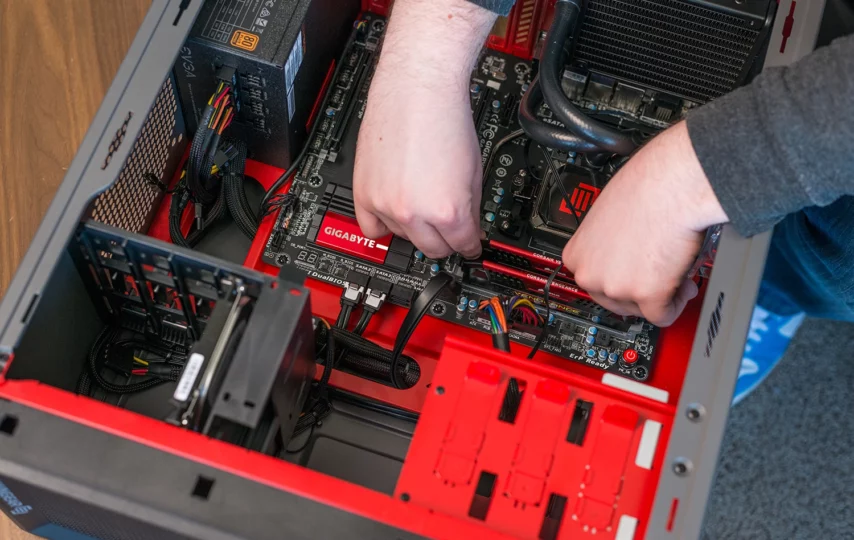Introduction to Building Your Own Computer
Building your own computer from scratch is a great way to get a custom-made, high-performance machine without spending a lot of money. It can also be a fun and rewarding project.
In this guide, we’ll walk you through the process of planning and building your own custom gaming PC. We’ll cover everything from choosing the right components to putting it all together and getting it up and running.
So whether you’re looking to save some money or just want the satisfaction of knowing you built your own machine, read on for everything you need to know about building a custom PC.
What You’ll Need to Build Your Computer
Building your own computer from scratch is a great way to get a custom, high-performance machine without spending a lot of money. But before you can start putting together your new dream machine, you’ll need to gather the right tools and components.
In this section, we’ll go over everything you’ll need to build your own computer, from the bare essentials to some nice-to-have extras. By the end, you should have a good idea of what you need to get started on your custom build.
The first thing you’ll need is a CPU (central processing unit). This is the brain of your computer, and it does all the heavy lifting when it comes to processing power. There are many different types and models of CPUs available, so doing some research ahead of time will help you choose the best one for your needs.
Once you have a CPU, you’ll need a motherboard to house it. The motherboard is the backbone of your system, and it needs to be compatible with both your CPU and the other components in your build. Again, there’s a lot of variety out there, so make sure to do your homework before making a purchase.
Next up are RAM (random access memory) modules. These are used by your CPU to store data temporarily while it’s working on something else. The more RAM you have, the more smoothly your system will run. 4GB is generally considered the minimum these days, but 8GB or more
The Steps to Building Your Own Computer
When it comes to building your own computer, there are a few things you’ll need to take into consideration. In this guide, we’ll walk you through the steps of building your own custom computer from scratch.
1. Choose Your Components
The first step is choosing all of the components that you’ll need for your new computer. This includes everything from the motherboard and CPU to the storage, memory, and graphics card. You’ll need to make sure that all of your components are compatible with each other before proceeding to the next step.
2. Assemble Your Computer
Once you have all of your components, it’s time to start assembly! This process will vary depending on the specific components you’ve chosen, but there are plenty of online resources and tutorials available to help you through it. Take your time and be careful not to force anything—if something doesn’t seem to fit, double-check that you have the right component before continuing.
3. Install Your Operating System
After your computer is fully assembled, it’s time to install an operating system. This can be done using a USB drive or disc; simply follow the prompts and choose your preferred OS during installation. Once everything is set up, you’re ready to start using your brand-new custom-built computer!
Customizing Your Computer
Assuming you’re starting with a blank slate, the first thing you’ll need to do is choose a motherboard. This will be the foundation of your system, so make sure to select one that will support all the devices and features you want. Once you’ve decided on a motherboard, it’s time to add a CPU. Again, make sure to pick one that’s compatible with your motherboard and that will offer the performance level you need.
Now it’s time to start adding in some memories. RAM is an important factor in overall system performance, so make sure to get enough to meet your needs. Once you’ve got your memory sorted, it’s time to add in a storage solution. You can go with a traditional hard drive or SSD, or opt for a hybrid solution if you want the best of both worlds.
Next up is your graphics card. This is an important choice if you’re looking to do any sort of gaming or other graphics-intensive tasks. Make sure to pick a card that’s compatible with your motherboard and that offers the right mix of performance and features for your needs.
Last but not least is your power supply. This is what will keep everything running smoothly, so make sure to pick a reliable unit that can handle all the components in your system. With everything selected and installed, you’re now ready to start customizing your new computer to better suit your needs!
Conclusion
Building a custom computer from scratch can be an intimidating process, but the rewards are worth it in the end. Having a PC that is tailored to your exact needs can provide you with the performance and customization options that factory-made PCs simply cannot match. With our guide, we hope that you now have all of the information and tips necessary to build your very own custom computer from start to finish – without breaking too much of a sweat!








